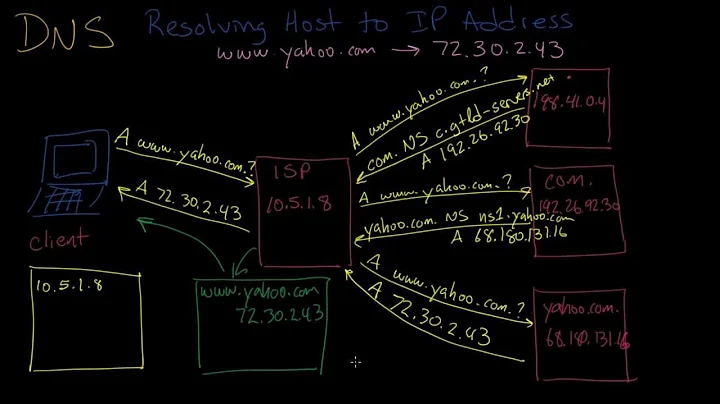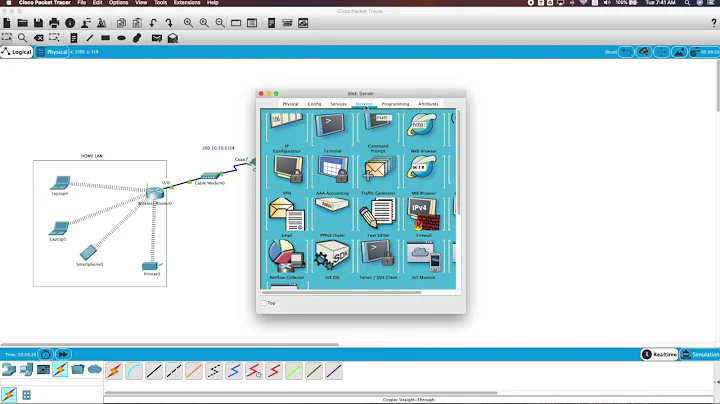DNS resolution for Lan website
Solution 1
You already have a DNS server
Your Windows Server 2012 machine already has the DNS role added if it's a domain controller. You just need to do a few things to get this set up:
- Configure forwarding
- Add a CNAME record for your website
- Point other machines to use this server for DNS
I don't have a Windows 2012 box ready, otherwise I'd screenshot the heck out of this. You might be able to find this stuff by fumbling around and Google'ing though. I'll give you the basics of what you're looking for.
Keep in mind this is all terribly, terribly simplified:
Configuring forwarding:
When your DNS server can't find an address it needs somewhere else to look. I like to add 8.8.8.8 as a forwarder (Google's DNS server). This way, when your client computers ask for Superuser.com, which your server doesn't have a record for, the request will be forwarded to 8.8.8.8.
Technet page on how to configure forwarding
Add a CNAME record
You'll need an address for your webpage. Adding a CNAME record to the forward lookup zone of your domain will give you a subdomain-style address. So if you've got usta.com for your domain and you add a CNAME record foobar, you'll get foobar.usta.com. This is a pretty common way to handle intranet pages.
You could add another forward lookup zone and then a www CNAME record to get whatever domain name you want, but then we're creating another forward lookup zone and risking collisions with domains you don't own. Let's just follow the KISS principle.
Use the DNS server!
Now we need to point our clients towards the DNS server. It's probably best to do this using DHCP. Get on your router's configuration page, find the DHCP settings, and replace the DNS server with the IP address of your Windows Server 2012. Now either wait for all the clients to renew or force them to renew.
You could also configure everything statically (ew) or configure only DNS statically.
Use the Googles!
To be honest, this answer isn't going to get you far. I am hoping though that it will help you learn where to look.
Solution 2
On the internal LAN, you would use the computers NetBIOS name as long as they are on the same IP segment. This is also the same as their DNS name if you are in a Windows domain environment. If the latter is true, you should already have an entry in DNS for the computer that is hosting the IIS web site. As noted in the previous response, you can add the computer name to the bindings within IIS to ensure that you can resolve properly to the web site.
If you truly want to be able to get to this site using dotted syntax (mycompany.com) then you will have to add another forward lookup zone and appropriate records in DNS for the name you want your users to use. You would then make sure the bindings in IIS match the name used in DNS.
Solution 3
Users on your network should already be able to access it without typing in your ip by using your computer's name. If you go into the server manager, look at what the computer's name is set up to be, within IIS you can create a binding to that name on all ports. Users will be able to use that name to access the website.
On a basic network, DNS lookups are done by your router. You can set up your router to do a forward lookup of another name, to your IP - if you did that, users would be able to find your website on the network by going to http://yourwebsite.yourdomain.yourdomainsuffix/ That would all be set up from your router's setup page.
If you can't do this from your router, then you would have to set your server up to be a DNS server. This is a windows server role, and it is not for the feint of heart. Once set up as a DNS server, you could go into DNS management and create a second forward lookup for your computer.
Related videos on Youtube
Niraj D Pandey
Updated on September 18, 2022Comments
-
Niraj D Pandey over 1 year
I am trying to make a chatbot. all the chatbots are made of structure data. I looked Rasa, IBM watson and other famous bots. Is there any ways that we can convert the un-structured data into some sort of structure, which can be used for bot training? Let's consider bellow paragraph-
Packaging unitA packaging unit is used to combine a certain quantity of identical items to form a group. The quantity specified here is then used when printing the item labels so that you do not have to label items individually when the items are not managed by serial number or by batch. You can also specify the dimensions of the packaging unit here and enable and disable them separately for each item.It is possible to store several EAN numbers per packaging unit since these numbers may differ for each packaging unit even when the packaging units are identical. These settings can be found on the Miscellaneous tab: There are also two more settings in the system settings that are relevant to mobile data entry:When creating a new item, the item label should be printed automatically. For this reason, we have added the option ‘Print item label when creating new storage locations’ to the settings. When using mobile data entry devices, every item should be assigned to a storage location, where an item label is subsequently printed that should be applied to the shelf in the warehouse to help identify the item faster.how to make the bot from such a data any lead would be highly appreciated. Thanks! is this idea in picture will work?just_a_thought
-
 theutonium.18 over 11 yearsThe IP is not the default, and I have a diff. site set to use the default interface.
theutonium.18 over 11 yearsThe IP is not the default, and I have a diff. site set to use the default interface. -
 theutonium.18 over 11 yearsI would have to add the 'friendly' name as well as the IP to the IIS binding field?
theutonium.18 over 11 yearsI would have to add the 'friendly' name as well as the IP to the IIS binding field? -
 theutonium.18 over 11 yearsI'll give that give that a try and see what happens.
theutonium.18 over 11 yearsI'll give that give that a try and see what happens. -
Niraj D Pandey over 5 yearsReally thanks for your answer. But on what basis TF/IDF selects the
startandendof the answer from text files? -
 Michal Bida over 5 yearsYou need to split the documents into paragraphs that can be then matched by
Michal Bida over 5 yearsYou need to split the documents into paragraphs that can be then matched byTF/IDFbased on the similarity to the question. The algorithm then finds the most relevant paraghraph. -
Giorgio Robino about 4 yearsyes! @Niray needs a full text search engine and I feel you are right: the old fashioned TF/IDF will be maybe a good solution without any AI "blackbox" on the cloud :)




